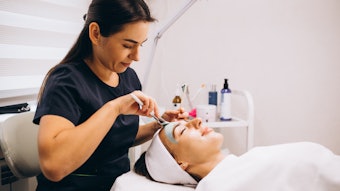
Whether it was molding Play-Doh into faces, building sand castles or sculpting clay into anatomic figures, Sam Rizk, MD, has been creating art ever since he was a child. His love of sculpting led him to study fine arts in high school and college, and he was floored by the works of master sculptors such as Lysippus, Michelangelo and Donatello.
“I was always a sculptor. I did a lot of sculpting in high school, and when I studied it in college, I learned more about all these great sculptors. I worked in clay, stone and alabaster, among others,” Dr. Rizk recalls. “I knew that I wanted it to somehow be part of what I did with my life. Art was and is important to me.”
His father was an anesthesiologist at Memorial Sloan Kettering in New York, and Dr. Rizk felt that following his lead into medicine and specializing in facial plastic surgery was the perfect opportunity to combine art and science.
“The only difference between sculpting and what I do in surgery is the healing process, because there’s no healing time in sculpting,” he says. “I was very interested in facial anatomy. I think it’s the most complicated part of the body.”
Dr. Rizk attended the University of Michigan Medical School and became an anatomy instructor, focusing on the head and neck. It was during this period that he first considered doing facial plastic surgery seriously.
“I thought it was so unusual, and it intrigued me,” he says. “There were so many nerves, arteries and veins all in one area that is so small, it was amazing.”
Today, Dr. Rizk is one of New York City’s most in-demand facial plastic surgeons, owning and serving as director of Manhattan Facial Plastic Surgery, a JCAHO-certified surgical facility on Park Avenue. He specializes in rejuvenating the nose, face, eyes and neck areas only, and that’s one of the things he believes makes him unique.
By concentrating solely on these areas, he has obtained vast practical experience and developed innovative techniques to match the needs of his patients, such as the rapid recovery facelift and natural-looking rhinoplasty.
Photograph by Michael Weschler
[pagebreak]
The Road to NYC
After obtaining his medical degree, Dr. Rizk held an internship in general surgery at Lenox Hill Hospital, then a residency in otolaryngology/head and neck surgery/facial plastic surgery at New York Hospital and Manhattan Eye, Ear & Throat Hospital. He followed that training with a certified fellowship in facial plastic surgery at the American Academy of Facial Plastic and Reconstructive Surgery (AAFPRS) in California.
It was always Dr. Rizk’s plan to open his own practice once his schooling ended. “I like to be my own boss,” he says. “As soon as I finished my fellowship, I started my own private practice (about 16 years ago). I was attending at Manhattan Eye, Ear & Throat Hospital, doing some teaching there to residents passing through, and I eventually became popular and opened my current practice on Park Avenue eight years ago.”
Not that there weren’t challenges at the beginning. A facial plastic surgeon in New York City is as common as a shoe store, so it was important to find a way to stand out in the oversaturated market.
“I needed to separate myself from the herd—and there is a large herd in Manhattan; it’s one of the busiest cities for plastic surgery,” he says. “I needed to find a way to show people how my skills and results were different, and it all came back to my art. For example, you can go to three equally qualified technicians and get three different results. It’s all about what makes Picasso different from Matisse; it’s about what your view of beauty is and what your artistic sense is. That’s what separates a good surgeon from a different good surgeon.”
Dr. Rizk knew that eventually his vision of beauty would make its way around the parties and events of the city, and he counted on patient-to-patient recommendations to make his presence known.
“You can’t hide your face, so when I do a facelift, for instance, I make my patients not only look younger but more beautiful,” he says. “Eventually, through word of mouth, you get more and more patients. You have to do exceptionally good work.”
Photograph by Michael Weschler
[pagebreak]
A Customized Approach
Dr. Rizk is board-certified by the American Board of Facial Plastic and Reconstructive Surgery (ABFPRS) as well as the American Board of Otolaryngology (ABOto). He repairs functional nasal conditions to improve breathing problems and other sinus conditions, and performs nasal reconstruction after cancer removal. He has also pioneered a new rhinoplasty technique where he creates a natural angle between the nose and forehead through a small intranasal incision—this is important as the angular relationship between the nose and other facial regions affects the perception of beauty and how natural the face looks.
“A customized approach resulting in a natural result, with a rapid recovery and the smallest undetectable (hidden) scars explains my philosophy,” says Dr. Rizk. “My facelifts and neck lifts do not just lift, but redistribute and fill areas of lost volume to make the face look more beautiful in addition to looking younger.”
He performs both open (external) and closed (endonasal/intranasal) rhinoplasty and has pioneered various innovative techniques, including 3-D high definition endoscopic rhinoplasty, cartilage reshaping with stitches, and the use of shorter internal incisions to achieve a natural result and a rapid, painless recovery.
Dr. Rizk also uses tissue glue instead of drains to close the wounds, resulting in less bruising and swelling, and leaving patients with an undetectable scar inside the ears.
He books extra time for each procedure, which allows him to do the “little things” that make each outcome unique based on a patient’s unique needs and anatomy.
“Instead of those pulled tight faces, I started doing different things with lips—lip lifts—that make the patients look prettier,” he says. “I added procedures, such as plumping up the cheek area, and decreasing the distance between the nose and upper lip. Doing all these tiny little things with the facelift or rhinoplasty will make the patient look younger and more attractive.”
For a patient with a nice jaw line and a long upper lip, for example, he knows plumping the upper lip with fillers won’t offer an optimal result: “It’s going to move forward, not up,” says Dr. Rizk. “You need to do a lip lift procedure to get that youthful component of the face.”
Photograph by Michael Weschler
[pagebreak]
Combining Modalities
Noninvasive tools, particularly dermal fillers, play a valuable role in his practice. “Volume has become a major part of our understanding of aging. Volume loss in the cheek area and lip makes a patient look older,” Dr. Rizk says. “If you do a great facelift and you don’t incorporate fillers, it’s not going to look great. If you study different stages of aging, and you look at older people to see how they age, it’s not just about looseness, it’s about volume loss. That part has to be incorporated to make a patient look more natural.”
Over the years, he has added several types of fillers to his practice and has been recognized in the industry for his advanced, minimally invasive surgical techniques, as well as his intraoperative and postoperative use of minimally invasive technologies.
For example, he uses autologous fat grafting to areas, such as the cheeks, temples, periorbital area, forehead, nasolabial folds and lips during facelift. “Fat is what gives the face volume, and volume is the hallmark of youth,” he says. Dr. Rizk is also using platelet-rich plasma to speed healing and rejuvenate the periorbital area.
“A unique characteristic of my practice is that I only do faces—60% rhinoplasty, but still more facelifts than most people on the east coast,” he says. “When people come in here, we give them a Four Seasons-like experience.”
Patients are treated to capuccino, espresso, lattes and cold beverages while they wait to be seen. All of his surgical patients are offered private registered nurses to care for them after surgery. His staff is frequently called upon to make hotel suggestions and reservations for out-of-town patients. Car service is also available on request to bring patients in for suture removal and follow-up care after surgery.
Many of Dr. Rizk’s patients travel from Europe, Asia and the Middle East to stay in New York for several weeks until they are fully recovered and the swelling and bruising has subsided. When patients have special needs, including hair stylists, massage therapists to administer lymphatic drainage treatments, manicurists or makeup artists, Dr. Rizk’s staff has a long list of vetted providers they can call on. He also routinely refers patients to other medical specialists, including dermatologists and ophthalmologists, as well as general plastic surgeons for breast and body procedures.
Photograph by Michael Weschler
[pagebreak]
Succeeding in Private Practice
When he first opened his practice, Dr. Rizk found that having a great office manager was integral, as it allowed him to focus more on surgery.
“I wake up in the morning and I’m happy to go to work,” he says. “It’s important to enjoy what you do because you’ll do it better.”
For those facial plastic surgeons thinking of following in his footsteps—especially those interested in New York City—he cautions them to do things a little differently than he did. “I would tell anyone who wants to open their own practice that first they should share office space with someone else and build their patient base to a good level. Then you can move out on your own,” he says. “The climate has changed since I did it. There are a lot more plastic surgeons now, and you don’t want to be in a situation where you have an office of your own and you’re not making ends meet.”
The best marketing, he says, comes from referrals, and Dr. Rizk receives many new patients from dermatologists, other physicians and the patients themselves—including celebrities, professional singers, politicians and professional athletes with nose injuries.
“My philosophy is always try to improve what you do. Don’t stay stagnant,” he says. “I always learn from my mistakes. Whatever procedures I do, I try to improve them and do things better the next time. I’m always working towards creating something better.”
Michelangelo couldn’t have said it better himself.
Keith Loria is a freelance writer based in Oaktown, VA.
Photograph by Michael Weschler











